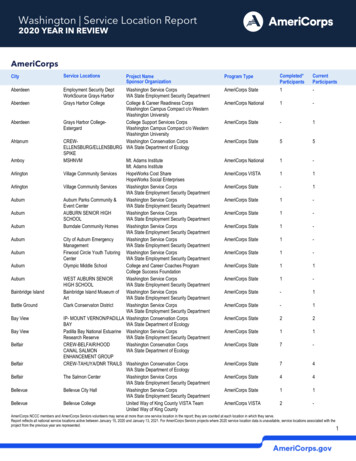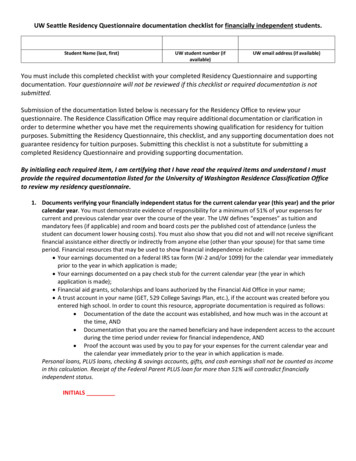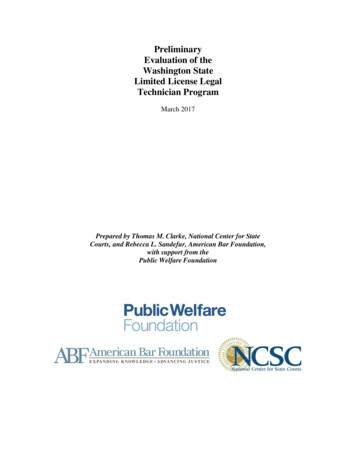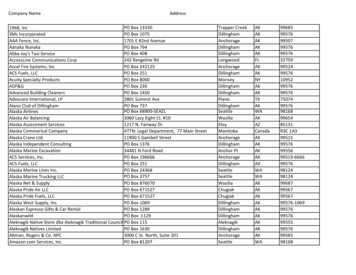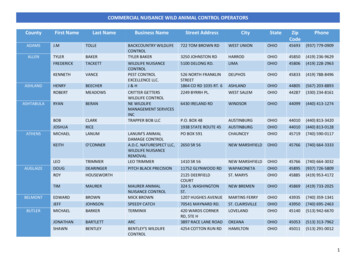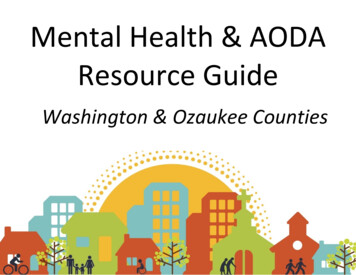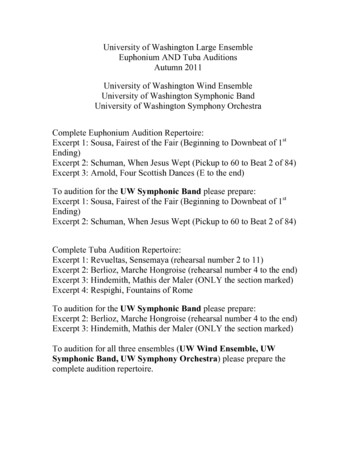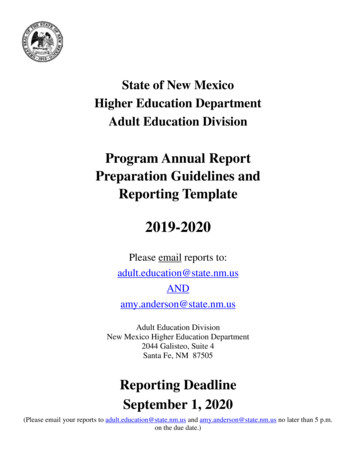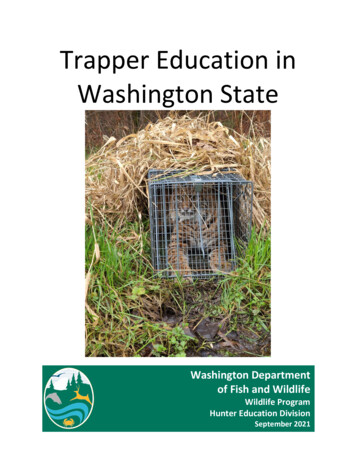
Transcription
Trapper Education inWashington StateWashington Departmentof Fish and WildlifeWildlife ProgramHunter Education DivisionSeptember 2021
CODE OF RESPONSIBLE TRAPPINGAll responsible trappers should adhere to the following code: Respect private property and ask permission from the landownerbefore the trapping season. Know selective and humane trapping systems and use themappropriately. Be aware of others using the outdoors and do not interfere with theiractivities. Assist property owners with wildlife damage problems. Avoid areas or sets likely to result in the capture of domestic animals.o Washington law requires that you release unharmed any trapped wildlifefor which the season is not open. Wildlife that cannot be releasedunharmed must be left in the trap and the Department of Fish and Wildlifemust be notified immediately. Be a conservationist. Make an effort to trap only the surplus. Check traps regularly and preferably in the early morning.o Don’t set more traps than you can check. Dispatch trapped furbearers in a humane manner and away fromother people. Promptly report wildlife problems such as disease, pollution, orhabitat destruction. Identify and record all trap locations accurately. Pick up all traps promptly when you have finished trapping. Utilize furbearer carcasses for human, domestic animal, or wildlifefood whenever possible. Dispose of unused carcasses properly. Provide educational assistance to new trappers. Support strict enforcement of laws relating to wildlife and wildlifehabitat. Respect the rights and feelings of others, even if you disagree withthem. Cooperate with wildlife management agencies.2
Table of ContentsHistory of Trapping . 5Furbearer Management . 5Carrying Capacity. 6Trapping Seasons and Regulations . 6Common Trapping Regulations Violations . 7Trapper’s Report . 7Responsible Trapping . 7Trapper's Image. 8Other Wildlife Users . 8Pre-season Preparation . 8Traps. 9Other Trapping Equipment . 11Health and Safety . 12Trapline Safety Reminders . 13Dispatching Trapped Animals . 13Animals on the Trapline . 14Terrestrial Animals . 15Aquatic Animals. 19Protected Animals . 22Furbearer Tracks . 25Furbearer Diseases and Parasites . 25Tips for Handling Diseased Animals . 26Furbearer Diseases . 26Fur Handling Equipment . 29Pelt Preparation . 31Skinning Your Catch. 31Fleshing the Skin. 31Stretching the Skin . 31Freezing Fur . 31Marketing of Fur . 32Local Sales . 32Selling by Mail . 33Auction Sales . 33Furbearer Recipes . 34Washington State Trappers Association . 37Wildlife Control Operator Program . 38Glossary . 38Bibliography . 393
This publication reflects the work of many entities, including the WashingtonState Trapper’s Association, the National Trapper’s Association, the MinnesotaTrapper’s Association, Alaska Department of Fish and Game, and the OntarioTrapper’s Association. The Washington Department of Fish and Wildlife website(wdfw.wa.gov) was utilized, and a number of Washington Department of Fish andWildlife employees were involved in developing and reviewing this latest editionof Trapper Education in Washington State.Any errors or omissions in this text are the sole responsibility of Hunter EducationDivision staff, who will appreciate receiving timely notice of your concerns athuntered@dfw.wa.govTHIS BOOKLET IS FOR INFORMATIONAL AND TRAINING PURPOSES ONLY!4
History of TrappingThe fur industry has been important throughout American history. From the first colonists on theAtlantic coast to modern day American society, trapping has played an important role. The first colonistsnot only traded for furs but also trapped for fur and food. Modern day trappers help manage wildlifepopulations and contribute fur to other industries.In Washington, the fur trade contributed to early settlement of the area. Major fur companies such asthe Pacific Fur Company, Hudson Bay Company, and North West Fur Company purchased furs,supported trappers, and encouraged development of fur trading posts and forts. Fort Okanogan, FortSpokane, Fort Vancouver, and Fort Nisqually were some of the fur trading posts in Washington.By the 1800s the fur resources were overexploited. The British had overharvested the resource inanticipation of losing control over a large portion of North America. Although the settlement of the westreduced the fur industry, it did not reduce the pressure on furbearers. Many of the new settlers trappedfor both fur and food. Unregulated trapping seasons allowed settlers to trap and hunt as manyfurbearers as they pleased which caused furbearer populations to drop to dangerously low levels in thelast half of the 1800s.To ensure their continued survival in Washington state, most furbearers have had managed seasonssince the early 1900s and all furbearers have managed seasons today. There are currently 28 speciesthat trappers can legally harvest in Washington. These animals are a collection of furbearers, small gameanimals, and unclassified animals.Furbearer ManagementThe department has three management goals for furbearers. They are to:1. Preserve, protect, perpetuate, and manage species and their habitats to ensure healthy,productive populations.2. Manage wildlife species for a variety of recreational, educational, and aesthetic purposes,including hunting, trapping, scientific study, cultural and ceremonial uses by Native Americans,wildlife viewing, and photography.3. Manage statewide populations for a sustained yield.Trapping is a management tool the Washington Department of Fish and Wildlife (WDFW or department)employs to ensure the populations of furbearers, small game animals, and unclassified animals do notexceed the carrying capacity, resulting in conflicts with humans or damaging the habitat. Many of theseanimals are carriers of parasites and diseases. Controlled harvesting can, in some cases, reduce theimpact of parasites and diseases on other wildlife and domestic animals.When setting trapping seasons, WDFW staff take into consideration population dynamics, when peltsare in prime condition for market, the number of trappers, and the harvest rate of animals. In situationswhere the department wants to establish a very limited open season for trapping of a furbearer butdecides the season length cannot effectively control the desired low harvest level, a quota system canbe used.Trappers in Washington must buy a license in order to trap. The revenue generated from the sales oflicenses and tags to individual hunters, trappers, and anglers makes up about 25% of the department’s5
budget. The sale of trapping licenses supplies the department with vital information on the numbers anddistribution of active trappers in the state. The mandatory report that licensed trappers submit at theend of the season also provides critical data for monitoring furbearer populations. When coupled withharvest figures, the license data can supply valuable information on trends involving trappers.Carrying CapacityCarrying capacity is a term that hunters and trappers hear often. It is defined as “the number of animalsthat the habitat can support throughout the year without damaging the habitat.” Good wildlife habitathas four basic requirements. The requirements are food, water, cover, and space. The requirementsshould be in the proper arrangement. Most animals require different things from their habitat, but aregenerally mingling with other animals that have their habitat needs met in the same areas.The carrying capacity of habitat evolves over time as it is influenced by yearly changes, land usepractices, weather, plant succession, and even the numbers and types of wildlife that use the habitat.The concept of carrying capacity is a key factor regarding wildlife management because a given amountof habitat can only support so many healthy animals. Social carrying capacity is a related term thatrefers to how humans tolerate wildlife in the shared environment. Support for wildlife can diminishwhen people experience negative interactions with wildlife and damage to private property. Mitigatingor preventing damage caused by wildlife is important for maintaining social carrying capacity of wildlifein human-dominated landscapes.The number of animals in a specific area can increase in late spring and may continue to rise as food andcover become more abundant. Most of the time, the increased number of animals are new young. Aswinter approaches and the food declines, the number of animals the habitat can support declines aswell. The animals outside the carrying capacity are known as surplus animals.Wildlife populations commonly fluctuate due to changes in the habitat. Changes in the habitat canseriously impact wildlife populations.Trapping Seasons and RegulationsSuccessful completion of trapper education training is required to purchase a trapping license. In-persontrapper education courses are taught by volunteer trapper education instructors, many of which are alsomembers of the Washington State Trappers Association. A home study option coupled with an in-personwritten examination is also available.RCWs:WACs:Trapping in Washington is governed by laws passed by the state77.15.190220-400-050legislature, successful public initiatives, and rules (or regulations)77.15.192220-400-060adopted by the Fish and Wildlife Commission. Regulations, including77.15.194220-416-010season dates, are published in the Furbearer Trapping Regulation77.32.545220-417-010Pamphlet. It is the responsibility of each trapper to obtain a trapping77.65.460220-417-020pamphlet and familiarize themselves with all current rules and seasons220-417-030prior to trapping. The trapping pamphlet is available online ns under Trapping. The220-450-030regulations contained in the back of this manual were valid at thetime of its printing.6
Be aware, the trapping pamphlet is not a complete list of all the laws and rules associated with trapping.To the right is a list of the current Revised Code of Washington (RCW) laws and WashingtonAdministrative Codes (WAC) that govern trapping. Trappers can check the current RCWs and WACs athttp://leg.wa.gov/ by selecting Laws and Rules in the top right corner.Common Trapping Regulations ViolationsThe most common violations of the trapping regulations are listed below:Failure to tag traps: All traps must be tagged with a metal tag exhibiting the trappers name and addressor their WILD ID.Failure to check traps: Nonlethal restraining traps (e.g., cage traps on land) must be checked andanimals removed within 24 hours of capture. Non-body gripping kill traps set in water such as colonytraps, funnel traps, and swim through traps must be checked and animals removed within 72 hours.Illegal trap: It is unlawful to trap wild animals with body gripping traps except with a special trappingpermit to abate an animal problem. These traps include but are not limited to: Conibear, coilspring,longspring, snares, and jump traps.Trespass: Always contact landowners and receive permission prior to trapping on their lands.Trapper’s ReportTrapper’s report forms tell wildlife managers how many, locations, and species of furbearers harvestedalong with the trapping effort, or number of trap nights, that it took to harvest those animals. Aftertrapping season has ended each year, individuals who have purchased a trapping license are required tofill out and return a trapper’s report before April 20. Information on trapper reporting is available onlinein the Furbearer Trapping Regulation Pamphlet at rappers can also contact the Wildlife Program customer service desk at 360-902-2515 to receive apaper copy. A report is required of all trappers who purchased a trapping license, even if they did notharvest any animals. The importance of filling out the trapper's report accurately cannot be stressedenough. The information on the report is important and needed by the department to managefurbearer resources.Responsible TrappingWashington’s wildlife is a public resource. The management, harvest, and marketing of furbearers arewatched by state and federal agencies, special interest groups, and interested citizens. Washingtontrappers are a small fraction of the state's total population. This small group of users is sometimesopposed by well-organized and vocal groups who think that trapping is inhumane, unnecessary, and canbe a threat to wildlife.Trappers must accept responsibility for their activities and actions. They must trap legally and ethically,with an understanding of the resource they are harvesting. Trapping laws and regulations are part of atotal wildlife management system that provides a flexible working structure to conserve resources aswell as allow the harvest of surplus animals.7
Trappers should strive to only remove the surplus animals. Many furbearer species have high birth anddeath rates. The high number of animals during the birthing season will not be able to survive the winterbecause the habitat will not be able to handle the increase in animal numbers. The ones that cannotsurvive are considered surplus animals. If these animals are not harvested, they will most likely die fromstarvation, disease, other predators, or many other causes.Trapper's ImageYou are the future of trapping. Your activities should show a responsible and ethical approach totrapping. The actions you take and what you say will help the non-trapping public form opinions abouttrappers and trapping. Remember that trapping can be an emotional issue that much of the public doesnot understand. If you think and act responsibly, ethically, and humanely, you will project a good imageof trapping. Conservationists and wildlife managers recognize trapping as the most efficient means ofmanaging some animal populations when it is conducted by responsible trappers. All trappers shouldfollow the trapper’s code that is listed on the inside cover of this manual.Other Wildlife UsersTrappers must accept that they share the wildlife resource with a wide variety of special interest groups.Since furbearers are a public resource and are found in areas where other outdoor activities may betaking place, trappers should be aware of these other activities and plan their sets accordingly. This willhelp ensure that the traps don’t accidently trap a pet. However, cage traps are designed to easily releasenon-target animals. Also, some of the public may not agree with trapping and might not want to seeevidence of the activity, especially the dispatching of a trapped animal. The challenge for all of us is tounderstand and accept each other's views and uses of our wildlife resources.Pre-season PreparationThe time to start thinking about trapping is in early fall. There are many things that must be done beforethe season opens in November. One of the most important things is to determine where you will betrapping. Whether it is posted or not, all land belongs toPre-season preparationsomebody. Many federal lands, state lands, and timbercompany lands are open to trapping. If you want to trap onchecklistprivate lands, you must obtain landowner permission, if notalready granted. It is up to the trapper to know where theyBuy a trapping licenseare and ensure they can legally trap in the location(s).Obtain landowner permissionWDFW has a webpage detailing places to go hunting at(if private property)https://wdfw.wa.gov/hunting/locations, which can also beScout for furbearer signused for trapping.Order trap tagsRepair and adjust trapsOnce the trapper has identified an area to trap andPrepare baits and luresreceived permission, if privately owned, they should startConsult trapping magazinesscouting for places to set traps. While prospecting for fur,and/or bookstrappers should carefully look for animal sign like tracks,Study the trapping regulationsdroppings, feeding areas, burrows, or even hair in fencesCheck that all vehicles andwhere animals squeeze underneath. Some trappers tie upequipment are in goodbait without traps in a favorite set location to see ifworking orderfurbearers are active in that area. When planning theConsideration should be givento getting a tetanus shot8
trapline, a trapper must always remember not to put out more traps than can be checked within thetime limit required by law.Trappers must use either their name and address or WILD ID number on their trap tags. You can findyour WILD ID on your trapping license. Early fall is a good time to send away for trap tags, which must beattached to every trap. Most if not all trapping magazines have ads for tags with your name and addressstamped on them. Be sure to order tags early enough so they arrive before you start trapping.Other chores that can be done before the season include: trap preparation, preparing baits/lures,ensuring motor vehicles are working, sharpening axes and knives, and ensuring all equipment is in goodworking order.Some trappers read books on trapping or subscribe to a trapping magazine. The more you can learnfrom these sources before trapping season, the more effective you will be. Trappers also tend to check alot of maps since they can show hidden ponds as well as access roads in an area. Many new trappersprefer to buy their lures from a reputable trapper supply house. This is probably a good idea becausethe quality of a lure can make or break your season.In late summer, the Washington State Trappers Association has its annual rendezvous in easternWashington. This event allows trappers to meet and exchange ideas and tricks on the trapline. Forinformation about the Washington State Trappers Association, please see their website athttp://www.watrappers.com/.Make sure to review the regulations and associated RCWs and WACs. Go through them again and againbecause it is your obligation to know the laws and rules. You may also want to have a copy on handwhen trapping to refer to in the field. Keep it in a waterproof bag or have it laminated to prevent waterdamage.TrapsExperienced trappers usually agree that it pays to buy the best traps available. Season after season, topquality traps keep working with only limited maintenance. Cheap traps, on the other hand, often startfalling apart after only a few weeks of use. However, cheap traps may be the way to go in areas wheretraps have been removed or stolen in the past. Remember to be aware of where you are placing trapsand what other animals may be using the area. Be familiar with current rules and regulations before youpurchase or use any traps!Body Gripping TrapsBody gripping traps are not allowed to be used for recreational trapping in Washington state. A bodygripping trap is defined in RCW 77.15.192 as, “a trap that grips an animal's body or body part. Bodygripping trap includes, but is not limited to, steel-jawed leghold traps, padded-jaw leghold or paddedfoot-hold traps, Conibear traps, neck snares, and non-strangling foot snares. Cage and box traps,suitcase-type live beaver traps, and common rat and mouse traps are not considered body-grippingtraps.” Traps that are body gripping may include but are not limited to: longspring traps, coilspring traps,single underspring traps, body-grip, and snares. Body gripping traps may be used with Special TrappingPermits issued by the department. You can apply for a special trapping permit athttps://wdfw.wa.gov/licenses/hunting/trapping.9
Cage TrapsCage traps: These come in many designs. Most arerather costly but will give years of service with aminimum amount of upkeep. If you are handy withtools you can build your own cage traps. A non-targetanimal can easily be released by just opening the door.It is critical that the trap sits perfectly flat and does notrock when the animal steps into the trap.Funnel traps: These traps are a cylindrical cage style trap placed in abody of water that has two funnels running into the cage area. Thefunnels are made to expand to allow furbearers in but to close backdown and trap them inside. These traps should be set below thewater line.Colony trap: These traps are generally box-style traps that areplaced on the bottom of a body of water with two doors, one on each side. The doors are in the downposition at time of setting and allow an animal topush open the door and enter the trap. The doorsare gravity driven and do not have a triggermechanism. Colony traps are trapping the entiretime they are in the water since the trap is nottriggered and does not need to be reset.Swim-Through trap: These traps are a two door cage style trap submerged in a bodyof water. They give the impression that the furbearer can swim through, but they tripthe closing mechanism when swimmingthrough.Weasel Box trap: These traps are a solid box with a trap inside.There is a hole only big enough for a weasel to enter. Generally,the box is wood or plastic.Suitcase-style Beaver Trap: The suitcase-style beaver trap is a spring-driven cage trap. The trap laysopen like a suitcase and when triggered the strong springs close the trap up and enclose the trappedanimal within the cage. Suitcase-style beaver trap placement is more versatile than a swim-through trapsince you don't need to find a narrow place to funnel beaver intothe trap. These traps are very strong and can be dangerous to setand place because of their large size and powerful springs. It’simportant to securely anchor the trap to something solid like a treeor rebar to ensure the trap stays in place after it springs. Whensetting the trap, make sure to use the safety ring to preventaccidental triggering of the trap and injury. After baiting the trap,use a long stick to disengage the safety ring.Below is a table of various dimensions of cage traps and what furbearers may be caught in each. Thistable is not a complete list of cage trap sizes and is only meant to illustrate that you can catch manyfurbearers with many different sizes of traps.10
Trap Dimensions5 x 5 x 246 x 6 x 247 x 7 x 177 x 7 x 249 x 9 x 249 x 9 x 4510 x 10 x 2410 x 12 x 4211 x 11 x 3612 x 12 x 3615 x 15 x 4815 x 20 x 4220 x 28 x 7220 x 26 x 48Furbearers it can catchShort-tailed and Long-tailed weasel,Short-tailed and Long-tailed weasel, MuskratShort-tailed and Long-tailed weasel, Marten, Muskrat, MinkShort-tailed and Long-tailed weasel, Marten, Muskrat, MinkShort-tailed and Long-tailed weasel, Marten, Muskrat, MinkShort-tailed and Long-tailed weasel, Marten, Muskrat, Mink, Raccoon, River otterMuskrat, Raccoon, River otterMuskrat, Raccoon, River otter, American badgerMuskrat, Raccoon, River otter, American badgerMuskrat, Raccoon, River otter, American badgerMuskrat, Raccoon, River otter, American badger, Beaver, Red foxMuskrat, Raccoon, River otter, American badger, Beaver, Red fox, BobcatMuskrat, Raccoon, River otter, American badger, Beaver, Red fox, BobcatMuskrat, Raccoon, River otter, American badger, Beaver, Red fox, BobcatTrap PreparationNew traps take some preparation before they are ready for the trap line. Many trappers go over them tomake sure the triggers work properly and there are no holes in the traps. Trap tags should be attachedat this point to ensure each trap has the required information attached to it. A good rule of thumb ontrap tags is to attach two tags to each trap, one on top and one on the bottom. This way you are alwaysin compliance with the law.Trap ModificationSome trappers today choose to make modifications to commercially available traps. However, with thecage traps currently legal in Washington state, modifications are not needed. Trap modifications cannotbe used to modify a cage trap to become a body gripping trap.Other Trapping EquipmentIn addition to traps, there are other pieces of equipment that are just as important on the trapline. Thissection will identify some of the standard equipment that most Washington trappers utilize. Rememberthat the following equipment is what has historically worked for most trappers and you need to findwhat works for you. As with most other pieces of equipment, buying the best quality usually pays off inthe long run. Some trapping equipment you may want to invest in includes: Hip boots or waders Extra trap tags Packbasket Gloves Axe Lures and baits Knife Rain gear Pliers Survival gear Digging toolHip boots orwadersTrappers who are working around water will want to invest in hip boots or chestwaders. These items are waterproof and will make trapping more comfortableand enjoyable. It is always a good idea to carry an extra pair (if you own multiplepairs) in your vehicle along with an extra set of clothes.11
PackbasketAxeKnifePliersDigging toolExtra trap tagsGlovesLures and baitsRain gearSurvival gearMany trappers carry their traps and animals in a packbasket made of wovenwood strips or fiberglass. Both types can be kept clean and relatively odor free byrinsing them out in a stream. Special pouches can be made or bought to beattached to the outside of your packbasket.Most trappers prefer a long-handled, single-bladed axe with a head weight ofabout three pounds.A knife is an essential tool for anyone in the outdoors. A pocket knife or belt knifeis great for trappers because they are small and light but sharp and effective atsmall tasks. Remember that blades dull and carrying a sharpener may be a goodidea.Trappers will want to have a good pair of pliers which can be used to repair trapsor replace trap tags on the trapline.Trappers may want to have a digging tool such as a shovel, trowel, hoe, or Pulaskifor use in setting their traps. Longer handles on these tools make them moreuseful, but long handles can stick out of the packbasket and catch low hangingbranc
traps, funnel traps, and swim through traps must be checked and animals removed within 72 hours. Illegal trap: It is unlawful to trap wild animals with body gripping traps except with a special trapping permit to abate an animal problem. These traps include but are not limited to: Conibear, coilspring, longspring,
